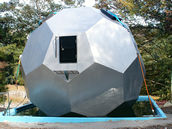 This last week, news services and blogs were filled with reports about President Bush's plan to put bases on the Moon and on Mars. This "Leave No Planet Behind" plan is budgeted to cost over a trillion dollars over the coming years, although the initial boost to NASA's budget is around $750 million -- that is, less than 1% of the total proposed cost. There are quite a few critics of this idea, but, perhaps surprisingly, many of the sharpest barbs come from decidedly pro-science, pro-space sources. The consensus criticism seems to be that, as with many other of this administration's programs, the high-minded proposal will be matched with strangled funding and a lack of real attention or resources. In short, it's election-year hype.
This last week, news services and blogs were filled with reports about President Bush's plan to put bases on the Moon and on Mars. This "Leave No Planet Behind" plan is budgeted to cost over a trillion dollars over the coming years, although the initial boost to NASA's budget is around $750 million -- that is, less than 1% of the total proposed cost. There are quite a few critics of this idea, but, perhaps surprisingly, many of the sharpest barbs come from decidedly pro-science, pro-space sources. The consensus criticism seems to be that, as with many other of this administration's programs, the high-minded proposal will be matched with strangled funding and a lack of real attention or resources. In short, it's election-year hype.
This is short-sighted and painful, for many reasons. It distracts from real issues at home. It will gut NASA's science budget. But the big reason, for me, is that it continues to spin the issue of space exploration as a "conquest of space," pseudo-military, plant-the-flag effort. It's not.
Exploring space is Green.
Exploring space is a crucial component of our ongoing efforts to better understand -- and protect -- our home planet. The hallmarks of good, solid Green thinking are a focus on sustainability, a bias towards the accumulation of knowledge, and a preference for long-term thinking. These are also the principles that make for a good space program. These two realms are inextricably linked.
Over the past few decades, notions of environmental sustainability moved from a focus on cleaning up pollution to a focus on understanding (and, where needed, responding to) global environmental systems. Picking up litter and reducing smog are easy concepts to understand; the dynamics between climate cycles, insolation, CO2 emissions from natural and artificial sources, and solar cycles are a bit more complex. Simply put, we can't understand the details of how our environment functions without a better understanding of the larger environment in which our planet exists, along with additional examples of planetary development. Turning our backs on space exploration means cutting ourselves off from a wealth of potentially-critical knowledge about our planet and solar system.
A space program with a planetary focus would combine current research into Earth's climate and geography (much of which can only be done from orbit) with expanded research into how the rest of our solar system works. Plenty of big questions about our planetary neighbors remain unanswered. Venus, Earth and Mars all orbit within our Sun's "habitable belt," and there is some preliminary research suggesting that each may have started out with similar potential for life. Why did Venus fall victim to a runaway greenhouse effect, while Mars dried up? Why did Earth alone manage to get through its early uninhabitable "iceball" period? We can speculate, but on-site exploration will give us far better answers than will remote theorizing. If climate change is the potential disaster that many of us suspect it could be, these are not idle questions. The better we understand how similar planets work, the better we can understand our own planetology.
Ultimately, the Sun drives our climate. But what's the role of the solar cycle on Earth's climate system? Some Greens play down the effects of the Sun on climate change because it has become a convenient way for climate refuseniks to dismiss human sources of global warming. But we really don't fully understand the relationship between solar "weather" and Earth's weather. More research is desperately needed, and this means sending out more probes.
There are myriad connections between space research and Green issues. The discovery of life in the oceans under the icy surface of Jupiter's moon Europa, for example, would be our first opportunity to learn more about how life functions on Earth by comparing it to life evolved under utterly disparate conditions. Proposals to send a robotic probe to drill through Europa's ice crust, however, remain unfunded.
For now, and likely for the next couple of decades, a Green space program would not mean sending people into space. Instead, it would emphasize the currently underfunded robotic-science part of NASA. The automated science missions have done remarkably well, considering how little money has been made available for them. The Mars Exploration Rover is the most spectacular recent example, but in over past months, automated probes gathered material from a comet, monitored solar weather, and dove into the crushing atmosphere of Jupiter. Such robotic missions cost much less than trying to send humans into space; prior to the Columbia disaster, a single shuttle launch cost around $500 million, nearly as much as the entire Mars Exploration Rover program. In the context of the larger American federal budget (and European budgets, for that matter), robotic space exploration is inexpensive -- and the information we get back, with the potential to help us better understand global environmental problems, is simply priceless.
That the Bush administration's current space proposal is wrong-headed, financially-disastrous, politically-motivated, and ultimately doomed should not lead those with Green inclinations to believe that all space efforts are so benighted. They're not. On the contrary, smart space efforts are an increasingly important tool in our ongoing work to understand and repair the Earth's environment. We discard it at our own peril.

 If you're even an occasional visitor to Blogistan over the past few days there's no way you could have avoided the abundance of celebratory links about the successful landing of the Mars probe "Spirit" (although I prefer the more dignified official name, "Mars Exploration Rover-A"). Here at WorldChanging, we're certainly ready to do our part to welcome our glorious new Martian overlords. Here are some interesting Mars-related links you may not already have encountered:
If you're even an occasional visitor to Blogistan over the past few days there's no way you could have avoided the abundance of celebratory links about the successful landing of the Mars probe "Spirit" (although I prefer the more dignified official name, "Mars Exploration Rover-A"). Here at WorldChanging, we're certainly ready to do our part to welcome our glorious new Martian overlords. Here are some interesting Mars-related links you may not already have encountered: One of the odder little bits of a typical Google results page has to be the "Similar pages" link for every hit. Clicking on it generates a list of other sites which usually (but not always) have thematic connections to the original. The
One of the odder little bits of a typical Google results page has to be the "Similar pages" link for every hit. Clicking on it generates a list of other sites which usually (but not always) have thematic connections to the original. The  Time to take a field trip!
Time to take a field trip! The
The 
 This last week, news services and blogs were filled with reports about President Bush's plan to put bases on the Moon and on Mars. This "Leave No Planet Behind" plan is budgeted to cost over a trillion dollars over the coming years, although the initial boost to NASA's budget is around $750 million -- that is, less than 1% of the total proposed cost. There are quite a few
This last week, news services and blogs were filled with reports about President Bush's plan to put bases on the Moon and on Mars. This "Leave No Planet Behind" plan is budgeted to cost over a trillion dollars over the coming years, although the initial boost to NASA's budget is around $750 million -- that is, less than 1% of the total proposed cost. There are quite a few  Over at
Over at  If you have a spare ¥6 million -- about $60,000 -- you too can have a home shaped like a
If you have a spare ¥6 million -- about $60,000 -- you too can have a home shaped like a 
 Reuters
Reuters